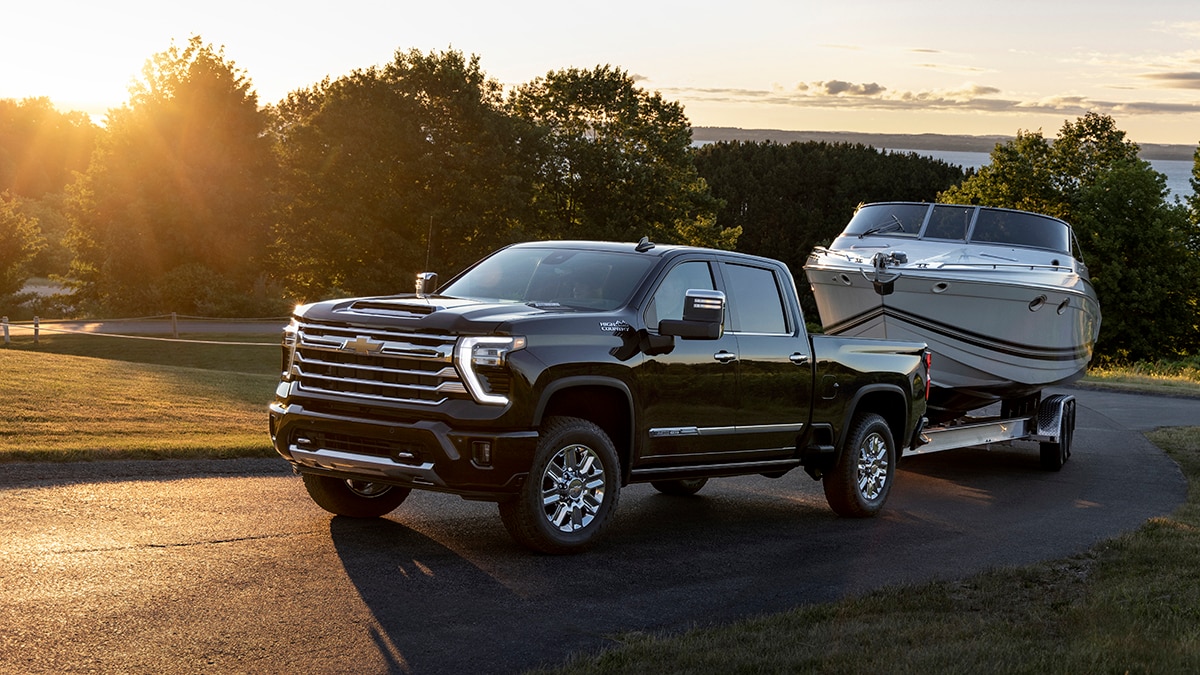Quick Facts About 1/2-ton, 3/4-ton, and 1-ton Trucks
- Full-size pickup trucks are classified as 1/2-ton, 3/4-ton, and 1-ton.
- 1/2-ton, 3/4-ton, and 1-ton are based on payload capacity.
- Payload is the total weight of people and cargo inside a truck’s cab and cargo box.
There is plenty of room for confusion when it comes to trucks. As a shopper, you must make decisions about the truck size, capability, cab style, engine, cargo box length, and the number of drive wheels needed before sorting through colors, features, and options. Just writing about it is exhausting. Here, we are going to assume that you’ve already cleared the compact (Ford Maverick), midsize (Chevy Colorado), or full-size (Ram 1500) size hurdle, landing on full-size trucks that best suit your needs. Now, you must confront the 1/2-ton, 3/4-ton, or 1-ton question. We will help with that here. We’ve provided jump links to simplify skipping ahead.
- What Does “Ton” Mean?
- What Is a 1/2-Ton Truck?
- What Is a 3/4-Ton Truck?
- What Is a 1-Ton Truck?
- Trucks Over 1-Ton
- Which Truck Is Better for You?
What Does Ton Mean?
For trucks, 1/2-ton, 3/4-ton, and 1-ton are comparison measures of a truck’s payload capacity. As you move from 1/2-ton to 3/4-ton and on to 1-ton, the payload capacity increases. Historically, these classifications meant a 1/2-ton truck had a 1,000-pound payload capacity, a 3/4-ton truck could accommodate a 1,500-pound payload, and 2,000 pounds was the maximum payload weight of a 1-ton truck. However, that is no longer the case. Each of these three classifications represents different payload maximums from one truck maker to the next. For example, the maximum payload capacity for a 1/2-ton Chevy Silverado 1500 differs from that of the 1/2-ton Ford F-150. More about the payload capacity of specific full-size truck models later.
What Is Truck Payload Weight?
To calculate a truck’s payload, total the weight of anything or anybody in the cab and the cargo box. Therefore, the payload includes the driver, passengers, and all their stuff, plus any cargo. Moreover, if the truck is towing a trailer, the trailer tongue weight is also included in the payload. As we’ve learned, payload weight maximums vary from one truck brand to another within the same classification. You can learn more about payload in our guide: What Is Payload: A Complete Guide.
RELATED: Towing Capacity Guide: Everything You Need to Know
What Is a 1/2-Ton Truck?
Most of the full-size pickups you see on the road are 1/2-ton trucks because this class is the most popular by far. Ford labels its 1/2-ton truck with the numerical 150. Chevy, GMC, and Ram identify their 1/2-ton entries with the 1500 numerical designation. Our list of 2024 1/2-ton trucks features a maximum payload weight limit based on specifications supplied by the manufacturer. Often, an upper trim level or optional engine is required to deliver a model’s range-topping payload weight capacity.
| Make and Model | Maximum Payload (pounds) |
| 2024 Chevrolet Silverado 1500 | 2,260 |
| 2024 Ford F-150 | 2,445 |
| 2024 GMC Sierra 1500 | 2,240 |
| 2024 Nissan Titan | 1,710 |
| 2024 Nissan Titan XD | 2,260 |
| 2024 Ram 1500 | 2,300 |
| 2024 Toyota Tundra | 1,940 |
What Is a 3/4-Ton Truck?
A 3/4-quarter-ton truck has a higher rating for payload and towing than its 1/2-ton sibling. Moreover, “Heavy-Duty” (HD), or “Super Duty” for Ford, often creeps into the model name. At Ford, F-250 designates 3/4-ton capability. Ram, GMC, and Chevy use 2500 to denote their 3/4-ton trucks. Neither Nissan nor Toyota make an HD version of their full-size pickup.
| Make and Model | Maximum Payload (pounds) |
| 2024 Chevrolet Silverado 2500 HD | 3,689 |
| 2024 Ford F-250 Super Duty | 4,268 |
| 2024 GMC Sierra 2500 HD | 3,850 |
| 2024 Ram 2500 | 4,010 |
What Is a 1-Ton Truck?
The 1-ton truck classification is where the rubber meets the road for non-commercial consumers. Also covered by the HD label, it’s the most capable class of trucks not engineered for business and commercial purposes. As with the 1/2-ton and 3/4-ton, we list the manufacturer-estimated payload maximums. However, to reach these weight limits requires dual rear wheels (DRW) on each side of the rear axle. You will hear an HD pickup with this setup referred to as a dually truck. With a single wheel on each side of the rear axle (SRW), the maximum payload would be roughly 2,500-3,000 pounds less.
| Make/Model | Max. Payload (pounds) |
| 2024 Chevrolet Silverado 3500 HD | 7,234 |
| 2024 Ford F-350 Super Duty | 8,000 |
| 2024 GMC Sierra 3500 HD | 7,290 |
| 2024 Ram 3500 | 7,680 |
Trucks Over 1-Ton
Trucks with even more capability target businesses and other commercial enterprises. The emphasis of trucks above the 1-ton classification is purely work. Ford offers models with ascending capability with the numeric identifiers of 450, 550, 650, and even 750. Silverado, Sierra, and Ram offer 4500 and 5500 versions, while Silverado and Sierra also market 6500 versions.
Which Truck Is Better for You: 1/2-Ton, 3/4-Ton, or 1-Ton?
In nearly any application, most drivers will be more than satisfied with a 1/2-ton truck. Under most circumstances, the 1/2-ton payload capability will be sufficient. We recommend that unless your needs involve towing exceptionally heavy loads, impacting the trailer tongue weight, stick with a 1/2-ton truck. HD trucks are all about extra capability, which, if you don’t need, there’s no reason to spend more to buy. Moreover, a 1/2-ton truck will deliver better fuel economy than either a 3/4-ton or 1-ton truck, saving you some serious money.
Related Truck Articles:
- Maximum Towing Capacity For Every Truck
- How to Launch a Boat and Protect Your Truck
- 5 Questions To Answer Before Choosing a Truck Bed Cover








